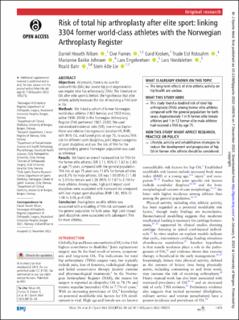| dc.contributor.author | Nilsen, Daniel Hoseth | |
| dc.contributor.author | Furnes, Ove Nord | |
| dc.contributor.author | Kroken, Gard | |
| dc.contributor.author | Robsahm, Trude Eid | |
| dc.contributor.author | Johnsen, Marianne Bakke | |
| dc.contributor.author | Engebretsen, Lars | |
| dc.contributor.author | Nordsletten, Lars | |
| dc.contributor.author | Bahr, Roald | |
| dc.contributor.author | Lie, Stein Atle | |
| dc.date.accessioned | 2023-03-02T13:10:31Z | |
| dc.date.available | 2023-03-02T13:10:31Z | |
| dc.date.created | 2023-01-05T13:27:15Z | |
| dc.date.issued | 2022 | |
| dc.identifier.citation | British Journal of Sports Medicine. 2023, 57(1), Side 33-39. | en_US |
| dc.identifier.issn | 0306-3674 | |
| dc.identifier.uri | https://hdl.handle.net/11250/3055414 | |
| dc.description | This is an open access article distributed in accordance with the Creative Commons Attribution Non Commercial (CC BY-NC 4.0) license, which permits others to distribute, remix, adapt, build upon this work non-commercially, and license their derivative works on different terms, provided the original work is properly cited, appropriate credit is given, any changes made indicated, and the use is non-commercial. | en_US |
| dc.description.abstract | Objectives: At present, there is no cure for osteoarthritis (OA), but severe hip joint degeneration can require total hip arthroplasty (THA). The literature on OA after elite sport is limited. We hypothesise that elite athletic activity increases the risk of receiving a THA later in life.
Methods: We linked a cohort of former Norwegian world-class athletes (1402 females and 1902 males, active 1936–2006) to the Norwegian Arthroplasty Register (THA performed 1987–2020). We used standardised incidence ratio (SIR), one-minus Kaplan-Meier and relative Cox regression (relative HR, RHR), with 95% CIs, and funnel plots at age 75, to assess THA risk for different sport disciplines, joint impact categories of sport disciplines and sex. The risk of THA for the corresponding general Norwegian population was used as reference.
Results: We found an overall increased risk for THA for the former elite athletes (SIR 2.11, 95% CI 1.82 to 2.40) at age 75 years, compared with the general population. THA risk at age 75 years was 11.6% for female athletes and 8.3% for male athletes. SIR was 1.90 (95% CI 1.49 to 2.31) for female and 2.28 (95% CI 1.87 to 2.70) for male athletes. Among males, high joint impact sport disciplines were associated with increased risk compared with low-impact sport disciplines (RHR 1.81, 95% CI 1.06 to 3.08, p=0.029).
Conclusion: Having been an elite athlete was associated with a doubling of THA risk compared with the general population for both sexes. High joint impact sport disciplines were associated with subsequent THA for male athletes. | en_US |
| dc.language.iso | eng | en_US |
| dc.subject | athletes | en_US |
| dc.subject | hip | en_US |
| dc.subject | sport | en_US |
| dc.title | Risk of total hip arthroplasty after elite sport: Linking 3304 former world-class athletes with the Norwegian Arthroplasty Register | en_US |
| dc.type | Peer reviewed | en_US |
| dc.type | Journal article | en_US |
| dc.description.version | publishedVersion | en_US |
| dc.rights.holder | © Author(s) (or their employer(s)) 2023 | en_US |
| dc.source.pagenumber | 33-39 | en_US |
| dc.source.volume | 57 | en_US |
| dc.source.journal | British Journal of Sports Medicine | en_US |
| dc.source.issue | 1 | en_US |
| dc.identifier.doi | 10.1136/bjsports-2022-105575 | |
| dc.identifier.cristin | 2101335 | |
| dc.description.localcode | Institutt for idrettsmedisinske fag / Department of Sports Medicine | en_US |
| cristin.ispublished | true | |
| cristin.fulltext | original | |
| cristin.qualitycode | 2 | |
